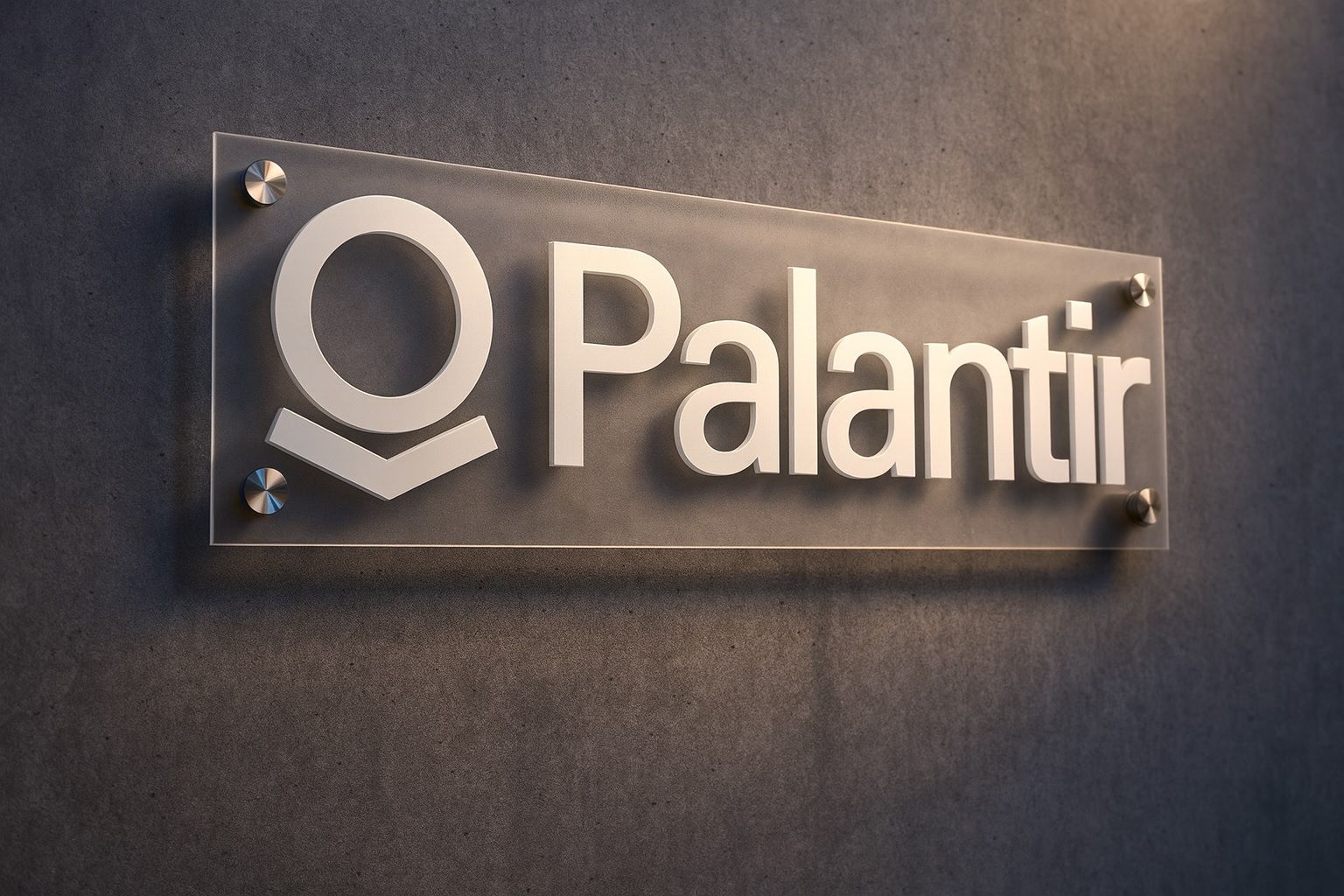- Current Price (Oct 13, 2025): ~$175 per share [1] (nearly 190 at August 2025 high).
- YTD Performance: +300% in 2025 (≈+148% year-to-date by early Sept) [2]; +1,800% since 2020 IPO [3].
- Market Cap: ≈$416–420 billion (top S&P 500 performer) [4] [5].
- Q2 2025 Results: Record revenue ~$1.03B (+48% YoY) with GAAP profit ~$327M (+144%). Management raised 2025 revenue guidance to ~$4.14–4.15B [6] [7].
- Major Contracts: US Army enterprise IDIQ (up to $10B/10yr) [8]; UK Ministry of Defence £750M AI deal [9]; Boeing Defense AI partnership [10]; new healthcare, energy, and automotive deals [11] [12].
- Valuation: Forward P/S >110×, forward P/E >210× (Citron) – far above peers [13] [14]. Many analysts see downside from current price; consensus 12-mo target ~$153 (≈–12% downside) [15].
- Analyst Views: Split market – bulls (e.g. Wedbush’s Dan Ives) hype AI’s upside [16]; bears (Citron’s Andrew Left) warn of “absurd” valuation (implying ~$65–$70 fair value) [17]. Price targets range $45–$215 [18].
- Technicals: After hitting all-time high $190 on Aug 12, stock has pulled back into mid-$170s. Chart indicators show RSI cooling from overbought, approaching 50-day MA (~$150) which may act as support [19]. Many see ~$150–$160 as key support zone [20] [21].
- Insider/Market Activity: Heavy retail trading & buzz (top StockTwits ticker in late Aug) [22]. Notably, insiders have sold shares after rallies (e.g. CIO Stephen Cohen sold ~191k shares at ~$151 in Aug 2025) [23].
Stock Price & Trend
As of Oct 13, 2025, Palantir shares trade around $175 [24]. The stock has rallied dramatically in recent years – roughly +300% in 2025, +360% over 12 months [25], making PLTR one of the hottest large-cap tech stocks. On Aug 12, 2025 PLTR hit an all-time high of $190.00 [26] [27]. Since then it has retreated to the mid-$170s. Trading volume has been unusually high, reflecting intense investor interest (StockTwits noted PLTR as its top-trending ticker in late August even amid a selloff) [28] [29].
Recent Trend: Over the past 2–3 weeks (early Oct 2025), PLTR pulled back about 7–8% from recent highs. October 10 saw the stock fall ~5% to $175.44 [30]. Investors are keeping an eye on news flow and technical support: chart analysts note Palantir’s RSI has cooled into neutral, and price is hovering above the 50-day moving average (~$150) [31]. Holding above ~$150 is crucial for the medium-term uptrend; a decisive break below ~$145–150 could signal a deeper pullback.
Latest News & Developments (Oct 2025)
Recent headlines have driven volatility in PLTR:
- US Army Security Memo (Oct 3): Reuters revealed an Army memo flagging serious security flaws in a new battlefield communications system (NGC2) co-developed by Palantir and Anduril. The memo labeled the prototype “very high risk” due to vulnerabilities like poor access controls [32] [33]. Palantir’s stock initially plunged (~–7%) on this scare [34], but the companies quickly clarified the issues were addressed in testing. Palantir stated “no vulnerabilities were found in the Palantir platform” [35], and the Army said the memo reflected an earlier prototype stage. After this clarification, PLTR rebounded ~+3% on Oct 6 [36] [37].
- Boeing Defense AI Partnership (Sept 23): Boeing Defense & Space announced it would integrate Palantir’s AI/data analytics platform across its manufacturing and classified programs. Boeing’s defense chief Steve Parker called the deal “game-changing,” saying it enables decisions “not in weeks, but in days and hours” using AI-driven data [38]. Palantir stock jumped ~+2% on the news [39] [40]. Analysts viewed this as a major validation of Palantir’s technology in aerospace.
- Healthcare & Enterprise Deals (Oct 6): Healthcare data firm OneMedNet selected Palantir’s AI Platform (AIP) to build a real-time analytics network for hospitals and research [41]. The CEO praised Palantir’s speed in delivering “regulatory-compliant data at remarkable speed,” enabling AI-driven breakthroughs [42]. Palantir also announced an AI “Nuclear Operating System” partnership in energy (a $100M deal to modernize reactor development) [43], and is expanding its Foundry analytics platform in sectors like healthcare (UK’s NHS) and automotive (Fiat) [44] [45]. These moves underscore Palantir’s push beyond defense into commercial/industrial AI.
- UK Ministry of Defence Contract (Sept 2025): Palantir won its largest-ever non-US contract: a £750 million ($950M) 5-year deal with the UK MoD to deploy its AI platform across military, health, and policing systems [46]. This roughly 10× exceeds Palantir’s prior UK business and signals strong Western defense demand. (Notably, this news broke just as President Trump visited London, highlighting the company’s geopolitical role [47].)
- Earnings Guidance (Aug 2025): In its Aug 2025 Q2 call, Palantir reported blowout results (discussed below) and raised full-year revenue outlook to $4.142–4.150B [48] [49]. CEO Alex Karp emphasized growth: “We are very, very bullish on America” [50], underscoring Palantir’s focus on U.S. federal spending. Chief Revenue Officer Ryan Taylor highlighted the “critical role” of Palantir’s AI solutions for customers [51].
Overall, recent news has been mostly positive (record contracts, partnerships, revenue beats), punctuated by the Army memo scare. Investors are digesting these developments amid high valuation.
Analyst & Expert Commentary
Wall Street and media analysts are deeply split on PLTR. Many bullish tech/AI strategists remain excited, while notable skeptics warn of a bubble:
- Bullish Views: Wedbush’s Dan Ives, a high-profile tech bull, calls Palantir a top pick on the grounds of the AI “gold rush.” He likens the AI boom to an “all-night party” that’s still early – “It was 9:00 p.m., it’s now 10:00 p.m., and it goes to 4:00 a.m.” [52]. Ives reiterated a Buy rating post-Q2, lauding the quarter as a “blowout” and emphasizing continued AI-driven demand [53]. Bank of America analysts (Mariana Perez Mora) have been optimistic: BofA recently raised its 12-month target to $215 (Sept 2025, the highest on the street) citing accelerating growth [54]. Many growth-focused funds and analysts point to Palantir’s dual engines (defense and enterprise) and say its recent performance is evidence that Palantir can capitalize on the AI/analytics wave [55] [56].
- Bearish Views: Short-sellers and value analysts caution Palantir is overhyped. Andrew Left of Citron Research has publicly scorned PLTR’s valuation as “absurd,” suggesting a fair value around only ~$65–$70 per share [57]. He notes Palantir’s core markets (government/enterprise) and argues growth could slow. On Oct 3, Citron noted PLTR’s forward P/E exceeds 210× [58]. Likewise, Morgan Stanley (Wall Street advisor on Palantir’s 2020 listing) has warned of an “overpriced” valuation relative to fundamentals [59] (though that was earlier in 2020). Even Salesforce’s CEO Marc Benioff (a competitor) has quipped about Palantir’s stratospheric valuation: he’s “so inspired” by its rise that it trades at “100 times revenue… maybe it’ll have 1,000 times [revenue] soon” [60], but also warned Palantir’s fees are the “most expensive enterprise software I’ve ever seen” [61]. This echoes criticisms that Palantir’s high-margin deals may limit market size.
- Consensus and Targets: On TipRanks and market surveys, about 8–10 analysts rate PLTR (roughly half Buy, half Hold/Sell) [62]. The consensus 12-month price target is only ~$153 [63] – implying about a 12–13% downside from current ~$175. Only a few analysts peg potential above $200 (TipRanks noted the high estimate is $215 [64] [65]), while pessimists have targets near $50–$70. In short, analysts see a wide band (roughly $45–$215 [66]) reflecting high uncertainty. (MarketBeat and StockInvest forecasts echo this range – for example, an AI-based model predicted ~$166–$210 by end-2025 [67], while many Wall Street models are closer to current levels or lower.)
Overall, experts emphasize Palantir’s strength in capturing government contracts and AI partnerships, but concern over valuation. As Zacks and others note, PLTR has excellent momentum, yet its multiples are “extreme” and sensitive to any sign of trouble [68].
Financial & Technical Analysis
Financials: Palantir’s fundamentals have improved dramatically. In Q2 2025, revenue exceeded $1.0B (up 48% YoY) with net income $327M (vs. a prior loss) [69] [70]. Adjusted free cash flow and margins are very healthy (rule-of-40 ~94, per [7] data). Government contracts remain key – Q2 U.S. sales grew 68% YoY [71], but the company stresses commercial growth too. CEO Karp attributes strong results to robust demand: “We are very, very bullish on America” [72] and expects government-linked revenue to keep growing under the current administration [73] [74]. Analysts note Palantir’s “land-and-expand” model: they win large initial deployments (often with defense agencies), then add commercial use-cases at the client (e.g. Air Force, Fiat, NHS) [75] [76].
Management says it will continue heavy R&D and hiring investment to fuel growth [77]. Indeed, SG&A and R&D expenses are climbing as Palantir builds its AI capabilities. The hope is that a sticky, mission-critical platform will justify the spend — if customers “rarely switch” away, revenue can compound.
Technical: From a chart perspective, PLTR’s long-term trend is still upward. After doubling in value by mid-2025 [78], the stock has simply cooled off from extreme levels. The RSI (momentum indicator) has dipped into neutral [79]. On Oct 3, PLTR traded ~–1.4% intraday around $184 but had retreated to $175 by Oct 10 [80] [81]. Short-term technicals show a pivot sell signal (double-top pattern) suggesting possible further short-term weakness [82]. Key support levels are ~$173 (recent lows) and the 50-day MA (~$150–155) [83]. Above, resistance lies near recent highs ~$187–190. Trading volumes remain elevated, so moves can be sharp.
In summary, the chart indicates a short-term pullback after the run-up, but no clear breakdown yet. Most technical analysts would wait for a close below $150–$155 to consider a bearish turn; as long as PLTR holds above that zone, the uptrend remains intact [84] [85].
Short-Term and Long-Term Forecasts
Short-Term: In the coming weeks (into late 2025), forecasts diverge. Some momentum models (like the StockInvest analysis) still see further upside. StockInvest’s AI backtest suggests PLTR’s short-term trend remains strong and predicts a ~+15% gain over 3 months (targeting ~$188 by Jan 2026) [86]. However, it also flags sell signals (e.g. pivot top on Oct 2) implying potential near-term pullback to low-$170s.
Wall Street’s near-term view is cautious: with the stock up so much, most analysts rate it Neutral/Hold [87]. They expect the real catalyst will be upcoming Q3 earnings (likely early November). TipRanks notes the median 12-mo target is ~$154 [88], implying minimal upside.
Technical analysts warn that if PLTR can’t clear the Sept 2025 highs ($190), it may fall toward the $150–$160 range, where many support levels cluster [89]. In fact, some mixed signals (growing insider sales, high short interest) have injected caution.
Long-Term: Over the next 1–3 years, the outlook depends heavily on Palantir’s execution and the AI market. Bulls argue that continued government spending and surging AI adoption could power PLTR well above current levels. For example, an AI-driven forecast model (via OpenAI’s ChatGPT) estimated a year-end-2025 price around $166–$210 (central ~$189) assuming strong growth [90]. A more bullish scenario sees Palantir cracking $200–$250 by 2026 if it keeps winning big contracts. Many investors point to Palantir’s “sticky” enterprise platform – once a client is embedded (like the Army or Boeing), additional modules and seats tend to follow.
Skeptics counter that Palantir is already priced for perfection. Citron and others warn that missing even modest targets could trigger a sharp re-rating back toward $100–$150. Some long-range bear cases even assume PLTR reverts to its pre-rally valuation (sub-$100) if growth slows.
Notably, Palantir’s own guidance is aggressive: management repeatedly raises long-term targets (4+ quarter-range) as performance exceeds expectations [91] [92]. However, if the AI hype fades or if large contracts disappoint, the stock could languish.
In summary: Most professional forecasts see moderate gains or sideways movement in the near term. Bulls say any dip will be a buying opportunity for long-term gains; bears say it’s time to take profits. The broad consensus target (~$153) suggests investors today are roughly evenly split between those outcomes [93].
Business Model and Partnerships
Palantir’s business rests on selling advanced software platforms (notably Gotham for defense/intel and Foundry/AIP for commercial/AI data) through large multi-year contracts. Key elements:
- Government Partnerships: Palantir’s roots are in U.S. defense/intelligence (CIA, DoD, homeland security). Over the past year, it has deepened ties with the U.S. Army (dozens of programs rolled into a single $10B IDIQ deal) [94] [95], and expanded to other services (Air Force, Navy) and allied militaries (UK MoD £750M deal) [96]. The new Trump administration’s focus on defense is expected to boost Palantir’s government revenue further [97]. Essentially, Palantir sells mission-critical analytics engines (often for battlefield or security uses) and then upsells additional modules.
- Commercial Growth: In parallel, Palantir is aggressively pushing into non-defense sectors. It uses a “land-and-expand” approach: deploy its platform in one part of a company or industry, then scale usage. Recent deals show this strategy: Boeing Defense will standardize on Palantir’s platform across its production lines (military jets, satellites) [98]; energy firms are using Palantir for nuclear plant analytics ($100M deal) [99]; carmaker Fiat and the UK’s NHS are expanding Foundry use for supply chain and patient data respectively [100]. The goal is to make Palantir not just a “defense contractor” but a go-to provider of enterprise AI analytics.
- AI Platform: Palantir’s core products (Foundry and the new AI Platform, AIP) are designed to ingest and analyze large datasets, with AI tools layered on. The company touts continuous enhancements: for example, in Sept 2025 it introduced “AIP Evals” (an automated AI testing suite) and new data-bridging features for Foundry [101]. These aim to keep Palantir at the cutting edge of enterprise AI. Palantir emphasizes that its software helps customers build and validate AI models faster, claiming its platforms give clients an advantage in data-driven decision-making [102] [103].
- Revenue Model: Contracts are typically high-value and multi-year (often $10–100M+ per deal). Palantir’s revenue is less recurring than pure SaaS – many sales are “fixed price” or usage-based over time rather than simple subscriptions. This leads to lumpiness: some quarters see big contract backlogs hit, others are quieter. However, once in place, usage tends to expand within clients.
In essence, Palantir’s strategy is to leverage its entrenched government base (a steady stream of large contracts) to fund expansion into high-growth commercial arenas (healthcare, energy, transportation). This two-pronged model is a key argument for bulls.
AI Capabilities and Competition
Palantir positions itself at the intersection of data analytics, AI, and cloud services. It competes with a mix of pure-play cloud/AI firms and legacy analytics companies:
- AI Strengths: Palantir’s AI Platform (AIP) allows clients to create, test, and deploy machine learning models on top of their data. The recent introduction of “AIP Evals” (auto-test generator for AI logic) [104] demonstrates Palantir’s push into enterprise AI tooling. The company claims its systems enable “near real-time” data sharing and analysis across complex organizations (military units, hospital networks, factories) [105]. Palantir’s founders argue that their tools have to meet strict security and compliance needs (e.g., clearances, data governance), which can be a differentiator over generic AI software.
- Key Competitors:
- Snowflake (SNOW): Another high-flying data platform. Snowflake reported ~60%+ revenue growth in Q2 2025, and its stock also surged in late Sept 2025 on earnings [106]. Snowflake focuses on cloud data warehousing with a simpler “pay-as-you-go” model, whereas Palantir’s model is more tailored services. Analysts set a lofty price target for SNOW (~$285) compared to Palantir, reflecting Snowflake’s predictability.
- C3.ai (AI): A former AI stock darling, now struggling. C3.ai warned of a large Q2 miss in August 2025, causing its stock to crash. Its limited growth contrasts with Palantir’s momentum. Some analysts observe Palantir has “mastered land-and-expand” where C3 has not [107].
- Other AI/Cloud Giants: Nvidia, Microsoft, and other cloud/AI leaders also vie for enterprise AI market. Many of these have higher scale; Palantir must differentiate via its software specialty and government ties. Interestingly, even Salesforce (a CRM/cloud giant) is now competing for government AI contracts. Palantir and Salesforce have clashed: Salesforce beat Palantir for a US Army contract by offering a lower-cost solution [108]. Salesforce CEO Benioff now praises Palantir’s strategy but also underscores its high prices [109].
- Competitive Position: Palantir’s unique selling point is its deep integration with clients and security posture. Once a military or enterprise begins using Palantir, it’s often mission-critical and hard to replace. As one analysis notes, Palantir’s consultants embed with customers, creating high switching costs [110]. This “stickiness” is cited as a moat. On the flip side, its high price tags and reliance on big-ticket contracts mean it must constantly innovate and justify each deal against cheaper alternatives.
In sum, Palantir’s competitive position is nuanced. It is seen as an AI/data leader in niche markets (defense, big enterprises) but faces rising competition from cloud incumbents. Its future hinges on whether it can grow into more mainstream markets without losing its edge.
Conclusion
Palantir (PLTR) today sits at a crossroads of euphoria and scrutiny. The company’s stock price reflects a best-of-times scenario: explosive growth fueled by AI optimism and multi-billion-dollar contracts [111] [112]. Its platforms are in high demand from governments and industries alike, and Q2 results proved the model is working for now [113] [114].
But at what cost? The valuation is sky-high, and analysts warn that any misstep could trigger a sharp correction. Historically, stocks of this nature (tech with a cult following, often called “glamour” stocks) can swing dramatically. Investors must weigh Palantir’s role in future AI-driven projects against the risks of an overheated market.
For the average investor or tech enthusiast, Palantir embodies both the promise and peril of the AI boom. It has indeed become a cultural phenomenon (“Palantir bros” and all) [115]. Yet its true test will be sustaining growth and execution: scaling into new industries without overpromising, and proving that its high-margin business is sustainable.
Sources: Authoritative analysis and news reports from TechStock² (TS2) [116] [117] [118], Reuters [119] [120], Investing.com [121] [122], Benzinga/TipRanks [123] [124], and others. These detail Palantir’s financials, contracts, market sentiment, and expert commentary as of mid-October 2025.
References
1. www.investing.com, 2. ts2.tech, 3. ts2.tech, 4. www.investing.com, 5. ts2.tech, 6. ts2.tech, 7. www.investing.com, 8. ts2.tech, 9. ts2.tech, 10. ts2.tech, 11. ts2.tech, 12. ts2.tech, 13. ts2.tech, 14. ts2.tech, 15. www.investing.com, 16. ts2.tech, 17. ts2.tech, 18. www.investing.com, 19. ts2.tech, 20. ts2.tech, 21. ts2.tech, 22. ts2.tech, 23. www.marketbeat.com, 24. www.investing.com, 25. ts2.tech, 26. www.tradingview.com, 27. www.investing.com, 28. ts2.tech, 29. ts2.tech, 30. stockinvest.us, 31. ts2.tech, 32. www.reuters.com, 33. ts2.tech, 34. ts2.tech, 35. www.reuters.com, 36. ts2.tech, 37. www.reuters.com, 38. ts2.tech, 39. ts2.tech, 40. ts2.tech, 41. ts2.tech, 42. ts2.tech, 43. ts2.tech, 44. ts2.tech, 45. ts2.tech, 46. ts2.tech, 47. ts2.tech, 48. ts2.tech, 49. ts2.tech, 50. www.investing.com, 51. www.investing.com, 52. ts2.tech, 53. ts2.tech, 54. ts2.tech, 55. ts2.tech, 56. ts2.tech, 57. ts2.tech, 58. ts2.tech, 59. www.reuters.com, 60. ts2.tech, 61. ts2.tech, 62. www.investing.com, 63. www.investing.com, 64. finbold.com, 65. www.investing.com, 66. www.investing.com, 67. finbold.com, 68. ts2.tech, 69. ts2.tech, 70. ts2.tech, 71. www.investing.com, 72. www.investing.com, 73. ts2.tech, 74. ts2.tech, 75. ts2.tech, 76. ts2.tech, 77. ts2.tech, 78. ts2.tech, 79. ts2.tech, 80. ts2.tech, 81. stockinvest.us, 82. stockinvest.us, 83. ts2.tech, 84. ts2.tech, 85. ts2.tech, 86. stockinvest.us, 87. www.investing.com, 88. finbold.com, 89. ts2.tech, 90. finbold.com, 91. ts2.tech, 92. ts2.tech, 93. www.investing.com, 94. ts2.tech, 95. ts2.tech, 96. ts2.tech, 97. ts2.tech, 98. ts2.tech, 99. ts2.tech, 100. ts2.tech, 101. ts2.tech, 102. ts2.tech, 103. ts2.tech, 104. ts2.tech, 105. ts2.tech, 106. ts2.tech, 107. ts2.tech, 108. ts2.tech, 109. ts2.tech, 110. ts2.tech, 111. ts2.tech, 112. ts2.tech, 113. ts2.tech, 114. www.investing.com, 115. ts2.tech, 116. ts2.tech, 117. ts2.tech, 118. ts2.tech, 119. www.reuters.com, 120. www.reuters.com, 121. www.investing.com, 122. www.investing.com, 123. ts2.tech, 124. ts2.tech







